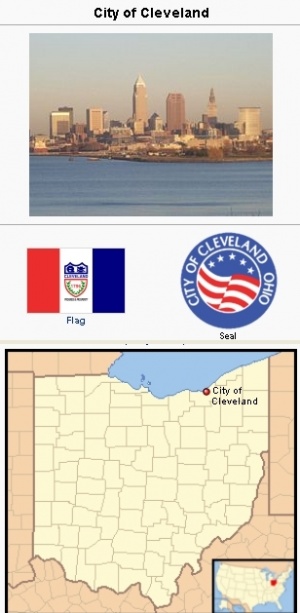Cleveland (Ohio, USA)

Cleveland, a metropolis of Ohio, is located on Lake Erie (coordinates: 41° 28′ 56″ N, 81° 40′ 11″ W). In 1950 it had a population of 914,000 (In 2000, 478,403). In the early 1830s and in the following years, a number of Mennonite families from the Palatinate, with such names as Risser, Leisy, Baehr, Pletcher, and Krehbiel, located near and within the limits of the present city. These families seemingly never organized a separate congregation, never had a meetinghouse of their own, nor a resident minister; for many years services were held in rented buildings by visiting ministers, including for several years after 1875, C. H. A. van der Smissen, who had charge of a church in nearby Ashland County. In 1862 Daniel Krehbiel, one of the prominent founders of the General Conference Mennonite Church, whose wife was a member of the Leisy family, moved from Iowa to Cleveland. In the General Conference sessions of 1869 to 1876 he served as a delegate from the Cleveland group. Krehbiel died in 1888. The congregation has long since become extinct. Some of the families moved away, and others joined other churches. Some of the descendants of the early settlers later played a prominent role in the business and political life of the city. The Leisys became the founders of the well-known Leisy Brewery interests. From 1910 to 1912 Herman C. Baehr served as mayor of the city. It was a matter of newspaper comment at the time of their inauguration into office that both the mayor and his district attorney, Cyrus Locher, a Mennonite from Bluffton, Ohio, true to their Mennonite heritage, substituted for the official oath the simple affirmation.
In 1948 the Gladstone Mennonite Mission (African American) was established in Cleveland. It was originally sponsored by the Plainview Mennonite Church (Mennonite Church), Aurora, Ohio, but later was under the Mennonite Board of Missions and Charities (Elkhart, Indiana). The Mennonite Witness to Israel mission, located southeast of the city, 52 Louis Road, Bedford, was established in 1947 and was under the Ohio Mennonite Mission Board. During World War II Mennonite conscientious objectors served in the several state mental hospitals in and near the city. In 1954 more than 140 Mennonite conscientious objectors (I-W men) were serving in the Cleveland area, with the Cleveland State Hospital as the chief employer.
Maps
| Author(s) | C. Henry Smith |
|---|---|
| Date Published | 1953 |
Cite This Article
MLA style
Smith, C. Henry. "Cleveland (Ohio, USA)." Global Anabaptist Mennonite Encyclopedia Online. 1953. Web. 1 Apr 2025. https://gameo.org/index.php?title=Cleveland_(Ohio,_USA)&oldid=170324.
APA style
Smith, C. Henry. (1953). Cleveland (Ohio, USA). Global Anabaptist Mennonite Encyclopedia Online. Retrieved 1 April 2025, from https://gameo.org/index.php?title=Cleveland_(Ohio,_USA)&oldid=170324.
Adapted by permission of Herald Press, Harrisonburg, Virginia, from Mennonite Encyclopedia, Vol. 1, pp. 626-627. All rights reserved.
©1996-2025 by the Global Anabaptist Mennonite Encyclopedia Online. All rights reserved.
